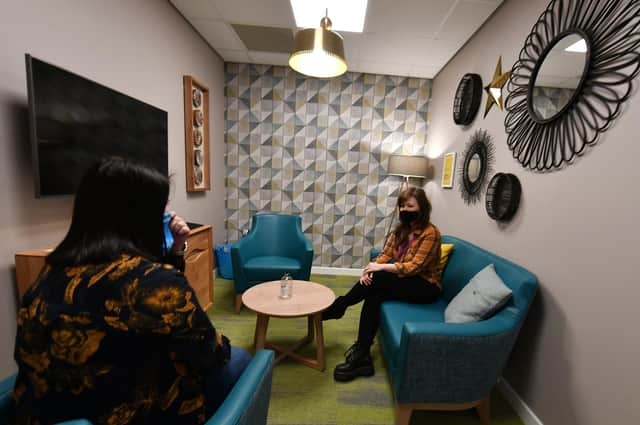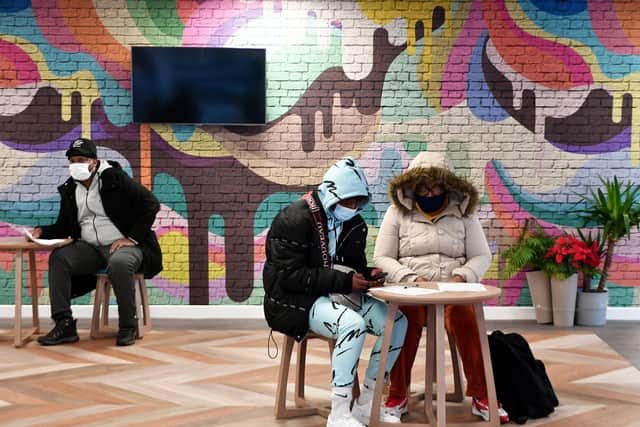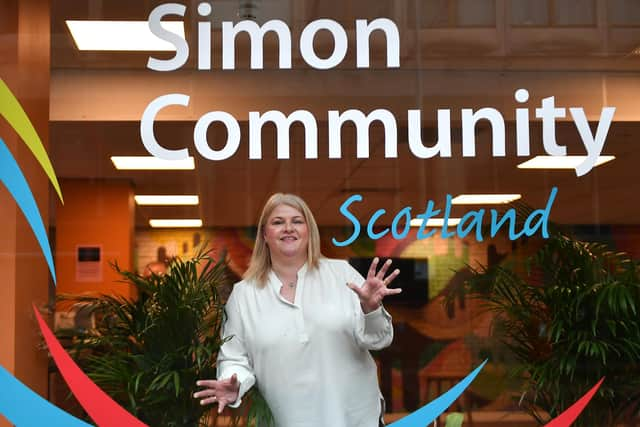Insight: How do you stay at home if you don't have one?


In the Simon Community Access Hub in Glasgow, Robert and Paul are talking excitedly about white goods. Last March, the friends - aged 36 and 26 - were living together in a tent in Maryhill. But when the pandemic struck, and efforts were being made to get rough sleepers indoors, they moved into a city centre hotel. After a few months, Paul left to serve a sentence in Barlinnie. But while he was away, Robert was handed the keys to his own flat; and when Paul got out of jail, he joined him there.
Today, the pair have been given a grant for a cooker and a fridge. “It’s going to be great,” says Paul, who describes himself as Robert’s carer. “We’ve been boiling a kettle to make noodles, or going to the City Mission for food, but I have a cooking qualification, and from now on I’ll be making us proper dinners.”
Advertisement
Hide AdAdvertisement
Hide AdPaul spent his childhood in and out of care, and his adulthood on and off the streets. “It’s so good knowing you can go inside and lock the door,” he says. “It’s peaceful, no worries, like. Finally, I have a home.”


Home: that emotive word. A place of heart and hearth; a shelter from the storm. The subject of a hundred wall plaque aphorisms, but also an ideal yearned across the globe. In equatorial rainforests and urban jungles; in the serenity of the suburbs and the chaos of conflict, people crave, not merely a roof over their heads, but somewhere they can call their own.
It’s a word that has been at the core of the pandemic. Stay at Home. Stay at Home. Stay at Home, the politicians keen. But what if you don’t have one? Or what if the one you have is dangerous or unsettled?
Scotland has the most progressive homelessness legislation in the developed world. Since the 2012 Commitment ended the distinction between priority and non-priority cases, everyone who is unintentionally homeless has a right to be accommodated. Yet, before the pandemic, many vulnerable people were falling through the cracks. According to Simon Community Scotland, up until March, Glasgow had 25-30 rough sleepers in its city centre while Edinburgh had 120 scattered throughout. More difficult to count were the hidden homeless: the sofa surfers and those who, as a result of their addictions, bounced from one B&B or hostel to another. In the year to March 2020, more than 30,000 households were assessed as homeless.
Edinburgh is affected by a shortage of social housing. But in Glasgow, which, as a dispersal city, has the added issue of asylum seekers with no recourse to public funds, the failure to house all its residents appeared to be systemic. In 2019, the city council illegally refused to accommodate homeless households on more than 3,800 occasions, prompting Shelter Scotland to threaten legal action and the Scottish Housing Regulator to launch an investigation.


But then along came the coronavirus, and everything changed. Faced with a public health emergency, and supported by the Scottish government, the council and third sector organisations pulled together to create a brand new system.
Within days of lockdown, Simon Community Scotland had taken over the Ibis Hotel in Glasgow and the Cairn Hotel in Edinburgh, running them as supported emergency accommodation for both rough sleepers and those who had suddenly become homeless as a result of the pandemic.
“The hotels were staffed with support workers 24/7,” says Hugh Hill, director of services and development. “And we had lots of volunteers as well. The people who picked you up in, say, Sauchiehall Street, would come and check up on you the next day.
Advertisement
Hide AdAdvertisement
Hide Ad“In Edinburgh, where people stayed for a while, we were able to do remarkable things with general vaccinations, sexual health nurses, online mental health support and GPs coming in a couple of times a week.”


In Glasgow, the Ibis guests were assessed and quickly moved on to other city centre hotels, such as the Alexander Thomson and the Rennie Mackintosh, which had been requisitioned by the city council. These hotels had no on-site support, though staff from Simon Community Scotland visited several times a week.
At the start of lockdown, moving people on from the hotels proved a challenge, but Covid also improved the relationship between Glasgow City Council and its 68 social housing providers. “The inability to carry out necessary repairs and refurbishment on void properties created a logjam, “ concedes Jim McBride, head of adult services for homelessness and community justice within the Health and Social Care Partnership. “But we got through that, and from August onwards, the Registered Social Landlords (RSLs) have been really supportive and delivered a huge amount of property for us to move people through.”
At the request of the Scottish government and councils, the RSLs have increased the percentage of the properties they allocate to homeless households, which has helped the city council to reduce the number of people living in hotels by 150 (a quarter). It also means that the quality and location of the properties has improved. “It used to be that homeless people would only be offered flats in high rises or in estates where no-one else wanted to live,” says McBride. “Now they are getting properties they could quite happily spend the rest of their lives in.”
All this is a good news story: a shaft of light in the bleakest of times. Yet - a year on - some are questioning the pace of progress. Shelter Scotland claims the 400 people still living in Glasgow hotels are effectively being “warehoused”. It is also concerned about repeated delays in the extension of the Unsuitable Accommodation Order which was supposed to ban councils from keeping anyone experiencing homelessness in substandard B&Bs or hostels for more than seven days.
“At the beginning of the pandemic we saw good leadership,” says Alison Watson, director of Shelter Scotland “but it feels to me now that people are being warehoused in empty hotels. The council should be saying: ‘We have all these people together, let’s engage with them and understand their needs; let’s make sure we break the cycle.’ I don’t see that happening.”
Hill, too, worries some of the initial zeal is fading. “ ‘We need to get this done, so let’s just do it ‘ has become ‘let’s talk about this’. The bureaucracy that exists within organisations is creeping back in.”
And the worst of the pandemic fall-out is still to come. As furlough ends and unemployment rises, so too will homelessness. The question is: can the new spirit of co-operation be sustained? Or will the changes brought about by the pandemic subside along with the infection rate?
A catalyst for change
Advertisement
Hide AdAdvertisement
Hide AdThe pandemic may have acted as a catalyst for change, but it also fuelled homelessness. Claustrophobic conditions can be combustible. While lockdown brought some families closer together, it drove others apart.
For while Fiona, who lives East Ayrshire, thought she had lost her teenage son, Ryan. “He was like a caged animal during lockdown,” she says. “His brothers were studying, we were working, he had nothing to do.” The minute lockdown was eased, Ryan went AWOL. “We didn’t know where he was. He was drinking, he was taking drugs. Eventually we heard from others he was living rough in the back lanes of a housing estate.”
Because he had left after a row, Ryan perceived himself as homeless. “We couldn’t get any support, not from the council, not from homeless shelters, not from our GP surgery - it was a nightmare.” The teenager, who was later diagnosed with ADHD, has been reunited with his family. One day he phoned Fiona, told her he loved her and asked to come home. Six months on, he has a job, and is doing well.
Other splits, however, have proved irreparable. Ashley Young, manager of the Simon Community Access Hub in Glasgow, agrees relationship breakdowns during lockdown have left some without a place to stay. But there were other factors, too. “Many of those who had been sofa surfing or living in unsettled accommodation were asked to leave,” she says. “Then there were those whose accommodation was tied to jobs they lost, and prisoners who were let out on early release with nowhere to go.”
Having worked with the Simon Community for 13 years, Young is still palpably excited by the changes in approach wrought by the public health emergency. “Councils do work at a slower pace,” she says. “There had been numerous conversations because they knew things weren’t working, but the pandemic forced everyone to be creative. Things changed dramatically overnight. No-one was precious about their own service users, they knew they needed to pull together to keep everyone safe.”
Everyone accepts there are risks attached to housing large numbers of troubled people, many of them with long-standing addictions, in city centre hotels. The staff at the Alexander Thomson, for example, had no experience in dealing with vulnerable people, although McBride says they were later trained in first aid and the provision of Naloxone, the antidote to a heroin overdose. Some former residents told me how distressed they were to have their doors banged in the middle of the night by those wanting to buy or sell street valium. There were nine deaths in the time it was open.
At the same time, housing them under the same roof provided an opportunity to get to know them.“Many of these people had a history of disengagement with services - they had been rough sleeping, begging, in and out of prison,” McBride says. “Using the hotels meant we were able to engage with a number of new people, who had never engaged with services at all. Most importantly, it meant that services could go to the individuals rather than the individuals having to go to the services.
"At the hotels, we were able to understand people’s complexity - to assess them using a red, amber, green system, and to give the support they needed.”
Advertisement
Hide AdAdvertisement
Hide AdThe Ibis was closed in September as the need for emergency accommodation diminished. The Alexander Thomson followed a few months later as residents moved into permanent accommodation.
The council is now working on housing those living in the Rennie Mackintosh. In the south of the city, Aspire and Wheatley are running two hotels in the south of the city as 24/7 supported accommodation.
“A woman who came into the Rennie Mackintosh Hotel the other day was assessed as being particularly vulnerable, so she was only there a night before being moved to supported accommodation,” McBride says.
“Services are much more joined up now and things seem to happen much more quickly. It’s like the hoops and red tape of the past have gone, the process has speeded up, and people are getting much better outcomes.”
He bristles at Watson’s criticism. “I find it appalling that Shelter describes this as ‘warehousing’,” he says. “We are in these hotels every single day managing people’s mental health, their drug and alcohol issues and their physical health.
“We have Housing First routes, where those with the most complex needs are moved onto permanent accommodation with support packages, we have a large number of people moving into flats where they have a degree of support and we have people moving onto tenancies with no support at all.
“But we have a cohort of people with long-standing issues who have had periods in prison, they have been evicted from properties, they are vulnerable to [exploitation] as well as posing a risk to others. You only have to look at the drug death figures. Some of these people do not want or could not cope with their own house.”
McBride said homelessness and addiction services had been working together throughout the pandemic. “These are frontline workers seeing people face to face. The dedication and commitment is beyond anything I have seen before and for Shelter to suggest we are warehousing people I think is dangerous and unfair.
Advertisement
Hide AdAdvertisement
Hide AdThe commitment of frontline workers notwithstanding, there are many hurdles to overcome in the effort to end homelessness.
One pressing issue is the number of households racking up rent arrears. As the pandemic wreaked financial havoc, the Scottish government banned evictions except in cases of criminality, domestic violence or serious anti-social behaviour. But this ban is due to end in March and even if it is extended a second time, it can’t go on forever. What then?
There is also the Tenant Hardship Loan Fund, which allows people who have had their finances impacted by the pandemic and do not have other means of support, to borrow up to nine months’ rent. But taking on a debt to pay off a debt could cause as many problems as it solves.
Beyond the pandemic, the Scottish government is committed to a shift towards Rapid Rehousing and Housing First. These policies mean that when people find themselves homeless, they will be accommodated quickly and not suffer the damaging experiences of staying in unsuitable temporary accommodation, such as B&Bs. Housing First is aimed at the most vulnerable and involves a greater degree of support.
“Rapid Rehousing is the cornerstone of the Scottish government’s Ending Homelessness Together plan,” Watson says. “In principle, it’s fantastic, but it feels to us it’s stuck on the starting blocks because there isn’t the accommodation to rapidly rehouse people into.
“The Homelessness and Rough Sleeping Action Group commissioned research looking at what would need to be in place for Rapid Rehousing to succeed and what it found was that both local authorities and RSLs would need to ramp up very significantly the percentage of the tenancies they allocated to homeless households.
“If you look at the latest figures from the Scottish Housing Regulator, [pre-pandemic] only about 44% of what we call social lets were allocated to homeless houses. The research said Rapid Rehousing would require between 60-65% of social lets to be allocated, so you can see it’s a significant gap.”
The mid to long-term solution is, as the Scottish government acknowledges, the construction of more social housing. But, Shelter claims, the £628.1m “More Homes” allocation, announced by finance secretary Kate Forbes in last week’s budget represents a cut of £268m when compared to the previous year. This cut will make it more difficult for the government to deliver the 53,000 new affordable homes, including at least 37,100 for social rent, which are said to be required by 2026.
Advertisement
Hide AdAdvertisement
Hide Ad“The Cabinet Secretary recognised that Covid has ‘underlined the value of a safe, secure and affordable home.’ But she chose to cut investment in social and affordable homes, at the same time as choosing to find an extra £100m for motorways, roads and air travel,” Watson says.
“Good quality housing is literally a matter of life and death.”
In the midst of such gloom, it is important not to lose sight of how much has been achieved.
Look at the way Glasgow City Mission’s winter night shelter - or the Glasgow Overnight Welcome Centre as it is now known - has been transformed. In the past, it consisted of rows of mattresses on the floor of a hall. But this year, it too has moved to a hotel, with guests given their own room and a hot meal every night. “It used to be people lying cheek-by-jowl on the floor,” fundraising manager Jack Geddes says.
“It fulfilled a purpose. It kept people off the street, but now everyone gets a hot meal and there’s a bit of dignity involved. I hope we never have to go back to the way it was before.”
McBride, too, is determined to build on the close working relationships forged during the pandemic.
“Our city centre risk management planning has involved working closely with the hotels, Police Scotland, third sector organisations,” he says. “In some respects we have been operating in a much more trusting environment than before which allows us to share more information and intelligence, particularly around the population target by drug users.”
Back at the Simon Community Access Hub, Michael is reaping the benefit of this new, improved, multi-disciplinary approach. The 38-year-old, who moved up to Scotland during the pandemic to be near his girlfriend, is clutching a freshly-signed tenancy agreement.
Advertisement
Hide AdAdvertisement
Hide Ad“I was homeless for eight years in England,” he says. “No-one helped me get my own place there. But I’ve been here five or six months and I have been given home, and all the help I’ve needed.”
Michael spent some time in the Alexander Thomson Hotel before securing the flat, which is five minutes from his girlfriend’s home in Castlemilk. He has already been to see it and can’t wait to move in.
“It’s up high with a gorgeous view over the city,” he says. “I love it.”
‘It took me a while to get used to the silence’
One of the issues during the pandemic has been a lack of joined up support for those leaving prison.
David McWilliamson, 36, left Barlinnie in May in the middle of the first lockdown. The only other time he’d been released from jail, he was met outside by a support worker who helped him find a hostel and get his benefits sorted, but this time there was no-one.
“I done really well inside with my recovery, and I came out with such good intentions, “ he says, “but I felt distressed and alone. I ended up contacting ‘friends’ and going back to my old ways. I took drink and drugs. I lost three days.”
David doesn’t remember much about what happened, but he ended up in hospital. A kindly nurse found him a place in a hostel - the St Enoch’s Hotel - and, once there, he contacted Natalie MacLean from SISCO, an organisation which ran recovery cafes in the jail.
At St Enoch’s Hotel, McWilliamson was hassled by someone he knew in jail who kept offering him drugs, so he was moved to the Queen’s Park Hotel, which was “stricter”. He spent six months there, before being given a temporary flat in Govanhill just before Christmas.
Advertisement
Hide AdAdvertisement
Hide AdThough he is happy with his new home, the transition wasn’t easy. “In the prison there were always people, there was always noise, in the hostel, there were always people, there was always noise, so when I came here, I felt quite isolated. It took me a while to get used to the silence,” he says.
But MacLean has continued to support him with his recovery. “I’ve always lived with someone else, so it still feels a bit weird,” he says. “But I’m lucky: I have a good support network and I’m being allowed to see my son and daughter again. Their mum’s been great. She knows I’ve turned my life around, so she lets me see them whenever I like.”
Comments
Want to join the conversation? Please or to comment on this article.